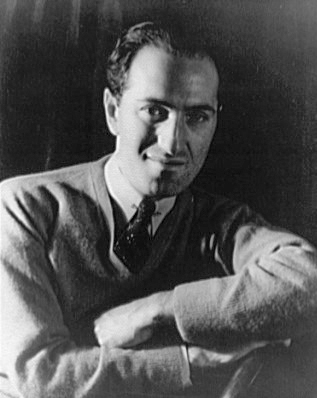
George Gershwin was an American composer and pianist whose compositions spanned popular, jazz and classical genres. Among his best-known works are the orchestral compositions Rhapsody in Blue (1924) and An American in Paris (1928), the songs "Swanee" (1919) and "Fascinating Rhythm" (1924), the jazz standards "Embraceable You" (1928) and "I Got Rhythm" (1930), and the opera Porgy and Bess (1935), which included the hit "Summertime".

Darius Milhaud was a French composer, conductor, and teacher. He was a member of Les Six—also known as The Group of Six—and one of the most prolific composers of the 20th century. His compositions are influenced by jazz and Brazilian music and make extensive use of polytonality. Milhaud is considered one of the key modernist composers. A renowned teacher, he taught many future jazz and classical composers, including Burt Bacharach, Dave Brubeck, Philip Glass, Steve Reich, Karlheinz Stockhausen and Iannis Xenakis among others.

Rhapsody in Blue is a 1924 musical composition written by George Gershwin for solo piano and jazz band, which combines elements of classical music with jazz-influenced effects. Commissioned by bandleader Paul Whiteman, the work premiered in a concert titled "An Experiment in Modern Music" on February 12, 1924, in Aeolian Hall, New York City. Whiteman's band performed the rhapsody with Gershwin playing the piano. Whiteman's arranger Ferde Grofé orchestrated the rhapsody several times including the 1924 original scoring, the 1926 pit orchestra scoring, and the 1942 symphonic scoring.

Ferdinand Rudolph von Grofé, known as Ferde Grofé was an American composer, arranger, pianist and instrumentalist. He is best known for his 1931 five-movement symphonic poem, Grand Canyon Suite, and for having orchestrated George Gershwin's Rhapsody in Blue for its 1924 premiere.
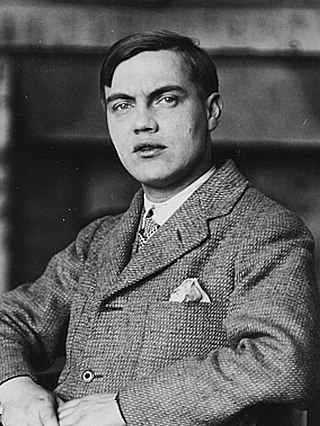
George Johann Carl Antheil was an American avant-garde composer, pianist, author, and inventor whose modernist musical compositions explored the sounds – musical, industrial, and mechanical – of the early 20th century. Spending much of the 1920s in Europe, Antheil returned to the United States in the 1930s, and thereafter composed music for films, and eventually, television. As a result of this work, his style became more tonal. A man of diverse interests and talents, Antheil was constantly reinventing himself. He wrote magazine articles, an autobiography, a mystery novel, and newspaper and music columns.
Ballet as a music form progressed from simply a complement to dance, to a concrete compositional form that often had as much value as the dance that went along with it. The dance form, originating in France during the 17th century, began as a theatrical dance. It was not until the 19th century that ballet gained status as a "classical" form. In ballet, the terms 'classical' and 'romantic' are chronologically reversed from musical usage. Thus, the 19th century Classical period in ballet coincided with the 19th century Romantic era in music. Ballet music composers from the 17th–20th centuries, including the likes of Jean-Baptiste Lully, Pyotr Ilyich Tchaikovsky, Igor Stravinsky, and Sergei Prokofiev, were predominantly in France and Russia. Yet with the increased international notoriety seen in Tchaikovsky's and Stravinsky's lifetime, ballet music composition and ballet in general spread across the western world.
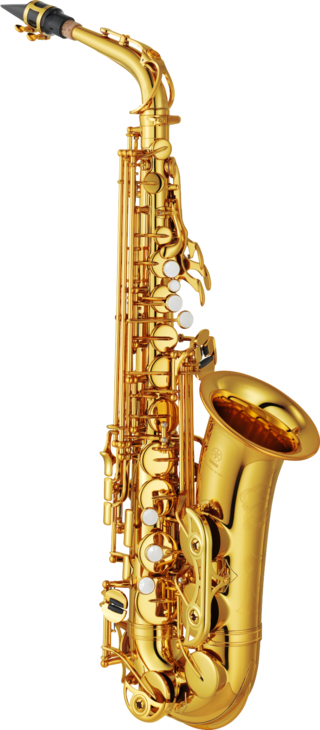
The alto saxophone is a member of the saxophone family of woodwind instruments. Saxophones were invented by Belgian instrument designer Adolphe Sax in the 1840s and patented in 1846. The alto saxophone is pitched in the key of E♭, smaller than the B♭ tenor but larger than the B♭ soprano. It is the most common saxophone and is used in popular music, concert bands, chamber music, solo repertoire, military bands, marching bands, pep bands, and jazz.
Concerto in F is a composition by George Gershwin for solo piano and orchestra which is closer in form to a traditional concerto than his earlier jazz-influenced Rhapsody in Blue. It was written in 1925 on a commission from the conductor and director Walter Damrosch. It is just over half an hour long.
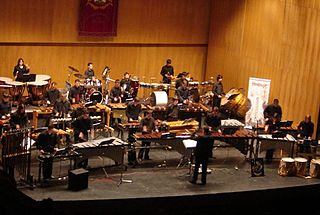
A percussion ensemble is a musical ensemble consisting of only percussion instruments. Although the term can be used to describe any such group, it commonly refers to groups of classically trained percussionists performing primarily classical music. In America, percussion ensembles are most commonly found at conservatories, though some professional groups, such as Nexus and So Percussion exist. Drumlines and groups who regularly meet for drum circles are two other forms of the percussion ensemble.

La Création du monde, Op. 81a, is a 15-minute-long ballet composed by Darius Milhaud in 1922–23 to a libretto by Blaise Cendrars, which outlines the creation of the world based on African folk mythology. The premiere took place on 25 October 1923 at Théâtre des Champs-Élysées in Paris.

Blue Monday was the original name of a one-act "jazz opera" by George Gershwin, renamed 135th Street during a later production. The English libretto was written by Buddy DeSylva. Though a short piece, with a running time of between twenty and thirty minutes, Blue Monday is often considered the blueprint to many of Gershwin's later works, and is often considered to be the "first piece of symphonic jazz" in that it was the first significant attempt to fuse forms of classical music such as opera with American popular music, with the opera largely influenced by Jazz and the African-American culture of Harlem.

Ballet Mécanique (1923–24) is a Dadaist post-Cubist art film conceived, written, and co-directed by the artist Fernand Léger in collaboration with the filmmaker Dudley Murphy. It has a musical score by the American composer George Antheil. However, the film premiered in a silent version on 24 September 1924 at the Internationale Ausstellung neuer Theatertechnik in Vienna presented by Frederick Kiesler. It is considered one of the masterpieces of early experimental filmmaking.
The Philadelphia Virtuosi Chamber Orchestra (PVCO) is a chamber orchestra that is located in Philadelphia, Pennsylvania. It was founded in 1991 by Daniel Spalding.
The Second Rhapsody is a concert piece for orchestra with piano by American composer George Gershwin, written in 1931. It is sometimes referred to by its original title, Rhapsody in Rivets.

American Rhapsody was written for the accordion by John Serry Sr. in 1955 and subsequently transcribed for the free-bass accordion in 1963 and for the piano in 2002. The composer was inspired by the classical orchestral works of George Gershwin along with various Latin jazz percussive rhythms utilized throughout South America while composing this opus.

Strike Up the Band is a 1927 musical with a book by Morrie Ryskind, lyrics by Ira Gershwin and music by George Gershwin. It first ran as a satirical show in Philadelphia that year, unsuccessfully, and on Broadway in 1930 after the original book by George S. Kaufman was revised by Ryskind. The show concerned a cheese manufacturer who sponsors a war against Switzerland because it will be named after him. Much of the satire of the 1927 version was replaced in the new version by silliness, leading Ryskind to recall, "What I had to do, in a sense, was to rewrite War and Peace for the Three Stooges." In the 1930 version the opening of Act I of the musical was reset from a cheese factory to a chocolate factory, and much of the work was a re-imagined as occurring during a dream sequence.
Third stream is a music genre that is a fusion of jazz and classical music. The term was coined in 1957 by composer Gunther Schuller in a lecture at Brandeis University. There are many ways to define third-stream music. It could refer to a group of jazz musicians playing solely, or a jazz soloist performing with a symphony orchestra, as long as the musicians are able to interpret and play jazz music. Improvisation is generally seen as a vital component of third stream. In third-stream music, composers incorporated elements of classical music, such as the use of jazz instruments and classical music forms, into their jazz compositions. The fusion of jazz and classical music is also viewed as "born out of a reciprocal interest: the interest of the classical community in the developments in jazz music and the interest of the jazz community in the advances of classical music." The innovative idea of fusing jazz and classical music pushed the boundaries of traditional classical music and introduced a new genre that blends the two styles into a unique hybrid form.
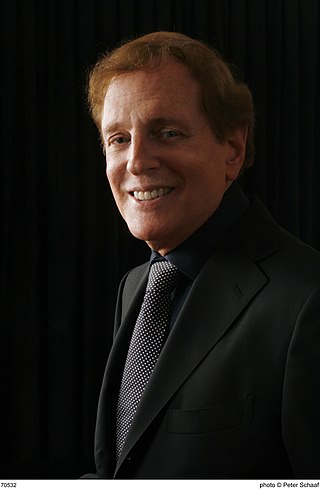
Steven Richman is a GRAMMY Award-nominated American conductor and writer. He is music director of Harmonie Ensemble/New York, which he founded in 1979, and the Dvořák Festival Orchestra of New York.
Harmonie Ensemble/New York is a musical organization based in New York City that performs and records an eclectic repertoire ranging from classical to jazz. Founded in 1979 by its conductor, Steven Richman, HE/NY has performed orchestra, chamber orchestra, symphonic jazz, big band, chamber, and wind ensemble works in virtually all of New York's concert halls, including Carnegie Hall, Alice Tully Hall at Lincoln Center, Merkin Concert Hall, and St. Peter's, and throughout the United States under Columbia Artists Management. It also appears on radio and television. HE/NY has received numerous awards, including a GRAMMY Award nomination, the Classical Recording Foundation Award in Carnegie Hall, Lincoln Center Community Arts Project, and the WQXR Action for the Arts Award.












